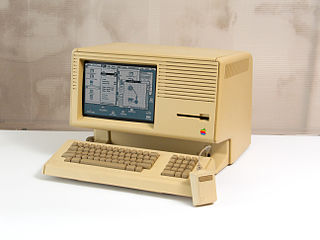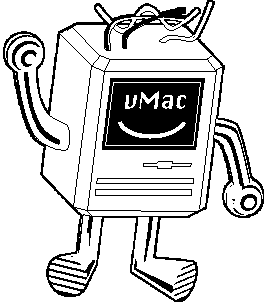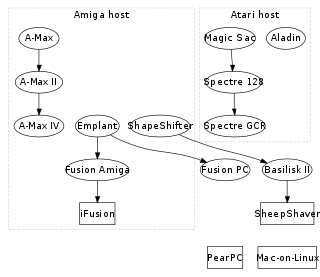Apple Lisa
In 1985, Sun Remarketing purchased between 5,000 and 7,000 unsold Apple Lisa computers from Apple Computers after the latter had discontinued it in September that year. The company had also acquired 3,500 unsold Apple III computers and thousands of used and broken Lisas from surrounding businesses in the same year. [3] : 43 [4] Sun sold roughly thousands of these consigned Lisas between 1985 and 1989, [4] the company modernizing the machines by retrofitting them with 800-KB 3.5-inch floppy disk drives and 20-MB hard drives. [5] Sun began reselling Apple's Macintosh line of computers in 1988, including Macintosh Plus, Macintosh SE, and Macintosh II, after years of having only sold the Lisa, Apple II, and Apple III. [6] In September 1989, Apple took the remaining 2,700 in their warehouse (which they had consigned to Sun) and buried them at a landfill in Logan, Utah. [4] [7]
Sun Remarketing bought the MacWorks XL emulator from Apple in the 1980s to spur sales of the Lisa computers by making them able to run Macintosh applications. Following the introduction of the Macintosh Plus by Apple with its enhanced 128K ROM, many new Macintosh applications no longer worked under MacWorks XL. To clear its remaining inventory, Sun Remarketing took the bold step of underwriting the development of a new emulator called MacWorks Plus which fully supported the 128K ROM on the Lisa hardware, and packaged it together as the Lisa Professional. [5] [8]

Lisa is a desktop computer developed by Apple, released on January 19, 1983. It is generally considered the first mass-market personal computer operable through a graphical user interface (GUI). In 1983, a machine like the Lisa was still so expensive that it was primarily marketed to individual and small and medium-sized businesses as a groundbreaking new alternative to much bigger and more expensive mainframes or minicomputers such as from IBM, that either require additional, expensive consultancy from the supplier, hiring specially trained personnel, or at least, a much steeper learning curve to maintain and operate. Earlier GUI-controlled personal computers were not mass-marketed; for example, the Xerox Alto was manufactured only for Xerox and select partners through Xerox PARC from the early to mid-1970s.

The Macintosh Plus computer is the third model in the Macintosh line, introduced on January 16, 1986, two years after the original Macintosh and a little more than a year after the Macintosh 512K, with a price tag of US$2,599. As an evolutionary improvement over the 512K, it shipped with 1 MB of RAM standard, expandable to 4 MB, and an external SCSI peripheral bus, among smaller improvements. Originally, the computer's case was the same beige color as the original Macintosh, Pantone 453; however, in 1987, the case color was changed to the long-lived, warm gray "Platinum" color. It is the earliest Macintosh model able to run System Software 5, System 6, and System 7, up to System 7.5.5, but not System 7.5.2.

The Macintosh Classic is a personal computer designed, manufactured and sold by Apple Computer from October 1990 to September 1992. It was the first Macintosh to sell for less than US$1,000.

The Macintosh 512Kenhanced (512Ke) was introduced in April 1986 as a cheaper alternative to the top-of-the-line Macintosh Plus, which had debuted three months previously. It is the same as the Macintosh 512K but with the 800K disk drive and 128K of ROM used in the Macintosh Plus. Like its predecessors, it has little room for expansion. Some companies did create memory upgrades that brought the machine up to 2 MB or more.

The Macintosh, later rebranded as the Macintosh 128K, is the original Macintosh personal computer, from Apple. It is the first successful mass-market all-in-one desktop personal computer with a graphical user interface, built-in screen, and mouse. It was pivotal in establishing desktop publishing as a general office function. The motherboard, a 9 in (23 cm) CRT monochrome monitor, and a floppy drive are in a beige case with integrated carrying handle; it has a keyboard and single-button mouse. The Macintosh was introduced by a television commercial titled "1984" during Super Bowl XVIII on January 22, 1984, and directed by Ridley Scott. Sales were strong at its initial release on January 24, 1984, at $2,495, and reached 70,000 units on May 3, 1984. Upon the release of its successor, the Macintosh 512K, it was rebranded as the Macintosh 128K. The computer's model number is M0001.

The Macintosh 512K is a personal computer that was designed, manufactured and sold by Apple Computer from September 1984 to April 1986. It is the first update to the original Macintosh 128K. It was virtually identical to the previous Macintosh, differing primarily in the amount of built-in random-access memory. The increased memory turned the Macintosh into a more business-capable computer and gained the ability to run more software. It is the earliest Macintosh model that can be used as an AppleShare server and, with a bridge Mac, communicate with modern devices.

Macintosh XL is a modified version of the Apple Lisa personal computer made by Apple Computer. In the Macintosh XL configuration, the computer shipped with MacWorks XL, a Lisa program that allowed 64 K Macintosh ROM emulation. An identical machine was previously sold as Lisa 2/10 with the Lisa OS only.

vMac is a free and open-source Macintosh Plus emulator which is able to run versions of System 1.1 to 7.5.5. It is available for Windows, DOS, OS/2, Mac OS, NeXTSTEP, Linux, Unix, and other platforms. Although vMac has been abandoned, Mini vMac, an improved spinoff of vMac, is still actively developed.

A Macintosh clone is a computer running the Mac OS operating system that was not produced by Apple Inc. The earliest Mac clones were based on emulators and reverse-engineered Macintosh ROMs. During Apple's short lived Mac OS 7 licensing program, authorized Mac clone makers were able to either purchase 100% compatible motherboards or build their own hardware using licensed Mac reference designs.
MacWorks XL is an Apple Lisa computer program which shipped with the Macintosh XL. It allows 64K Apple Macintosh ROM emulation so the Macintosh XL can run classic Mac OS programs.

The Spectre GCR is a hardware and software package for the Atari ST computers. The hardware consists of a cartridge that plugs into the Atari ST's cartridge port and a cable that connects between the cartridge and one of the floppy ports on the ST. Designed by David Small and sold through his company Gadgets by Small, it allows the Atari ST to run most Macintosh software. It is Small's third Macintosh emulator for the ST, replacing his previous Magic Sac and Spectre 128.
The original Macintosh was a relatively simple machine, now of interest for its simplicity and for the fact that it was the first computer produced by Apple under the name Macintosh. The Macintosh used standard off-the-shelf components to the greatest extent possible, achieving a moderate price point by mixing complex LSI chips, readily customizable programmable array logic, and off-the-shelf components.

The Macintosh Quadra 605 is a personal computer designed, manufactured, and sold by Apple Computer from October 1993 to July 1996. The model names reflect a decision made at Apple in 1993 to follow an emerging industry trend of naming product families for their target customers – Quadra for business, LC for education, and Performa for home. Accordingly, the Performa 475 and 476 was sold in department stores and electronics stores such as Circuit City, whereas the Quadra was purchased through an authorized Apple reseller.

The Macintosh Quadra 660AV, originally sold as the Macintosh Centris 660AV, is a personal computer designed, manufactured and sold by Apple Computer from July 1993 to September 1994. It was introduced alongside the Quadra 840AV; the "AV" after both model numbers signifies video input and output capabilities and enhanced audio.
MacWorks Plus was a complete implementation (port) of the Macintosh Plus 128K ROM on the Apple Lisa and Macintosh XL computer systems, and introduced in August 1988. It was developed for Sun Remarketing of Cache Valley, Utah, under license from Apple Inc., by a contract developer named Chuck Lukaszewski, who was responsible for versions up through 1.1(h), which supported up to Macintosh System 6.0.3. Dafax Processing Corp. with the assistance of Query Engineering, Inc. then further developed the environment to MacWorks Plus II, which continued Macintosh system support up to System 6.0.8 with the Basic version, and introduced a Pro version to extend support to the maximum possible for any 68000 processor: System 7.5.5. Prior to MacWorks Plus, the maximum system supported by its predecessor MacWorks XL was System 3.2.
The Macintosh Hard Disk 20 is the first hard drive developed by Apple Computer specifically for use with the Macintosh 512K. Introduced on September 17, 1985, it was part of Apple's solution toward completing the Macintosh Office announced in January 1985. It would be over a year more before Apple would release the file server software AppleShare that would link all of the hardware together. By that time the SCSI interface introduced on the Macintosh Plus in January 1986, would accommodate far faster and more efficient hard drives, rendering the Hard Disk 20 virtually obsolete.

Mac OS is the series of operating systems developed for the Macintosh family of personal computers by Apple Computer, Inc. from 1984 to 2001, starting with System 1 and ending with Mac OS 9. The Macintosh operating system is credited with having popularized the graphical user interface concept. It was included with every Macintosh that was sold during the era in which it was developed, and many updates to the system software were done in conjunction with the introduction of new Macintosh systems.

The MacEnhancer is an expansion box originally developed in 1985 by Microsoft for Apple Computer's original Macintosh. Plugged into either the Macintosh's serial printer or modem ports, the MacEnhancer provides IBM-standard printer and serial ports as well as a passthrough for the Mac-standard serial port, for a net gain of three peripheral ports. Along with a provided disk of drivers, this expansion box allows the Macintosh to run a host of printers and other business peripherals not originally supported by Apple.

Aox Inc. was a privately run American technology corporation founded by Michael and Linda Aronson in 1978. Over the course of its 22-year lifespan, the company chiefly developed software and hardware for IBM's PC and compatibles, for the Personal System/2, and for the Macintosh. In its twilight years, the company designed multimedia and teleconferencing devices and chip designs. Aox was founded after Michael Aronson graduated from Harvard University with a doctorate in physics; he stayed with the company until 2000, when he incorporated EndPoints Inc. and switched to full-time fabless semiconductor design.

Dayna Communications, Inc., was a privately-held American computer company, active from 1984 to 1997 and based in Salt Lake City, Utah. It primarily manufactured networking products for Apple Computer's computing platforms, including the Macintosh, PowerBook and Newton. In 1997, the company was acquired by Intel for nearly $14 million.
















